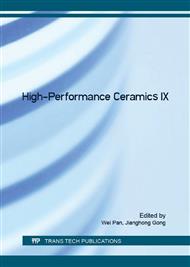p.612
p.617
p.623
p.629
p.633
p.639
p.644
p.648
p.652
Effects of Sintering Temperature and Excess Zr on Mechanical Properties of Reactive Hot-Pressed ZrB2-ZrCx-Zr Cermets
Abstract:
In this study, a series of ZrB2-ZrCx-Zr cermets were prepared by reactive hot-pressing of Zr + B4C powder mixtures at different temperatures between 1400°C and 1900°C. The microstructure of the resulting cermets was characterized by field emission scanning electron microscopy. The strength and fracture toughness of the cermets were measured by four-point bending test at room temperature. The results showed that the strength and fracture toughness dependend on the amount of excess Zr and sintering temperature as well. In addition, the crack propagation behavior of the cermets was examined under indent cracking. The cracks induced by indenter directly propagated in the samples with less than 16 vol% Zr. For comparison, the multiple cracking behavior was observed for the samples with equal to or greater than 16% Zr. Furthermore, the effects of compositions and sintering temperatures on the microstructure and the mechanical properties of the cermets were discussed.
Info:
Periodical:
Pages:
633-638
Citation:
Online since:
July 2016
Authors:
Price:
Сopyright:
© 2016 Trans Tech Publications Ltd. All Rights Reserved
Share:
Citation:


